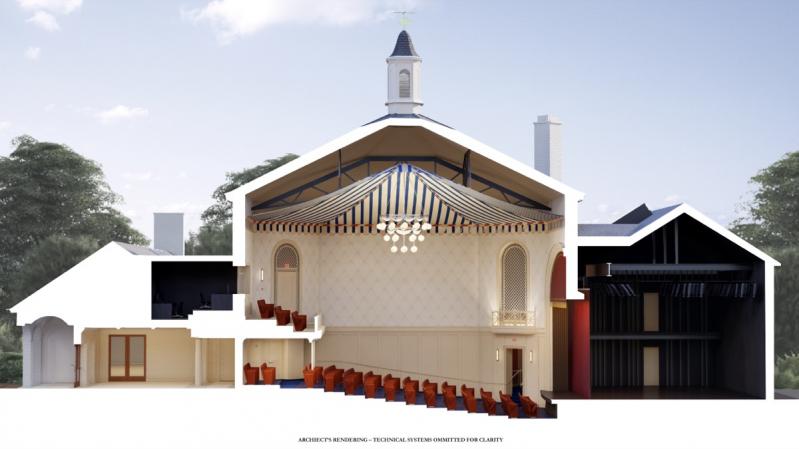After concerns were raised by the community and preservationists, East Hampton's Guild Hall has scaled back the ambitious plans for its theater, announced in February and described by one critic as "cruise ship planetarium" in style. Instead, it will preserve many of the space's historical architectural elements and keep them visible in the final design, while upgrading the overall experience of productions there.
"We are making our theater, museum, and education space responsive to the innovative presentation needs of today's artists with the latest tools and technologies," said Andrea Grover, Guild Hall's executive director. "Our upgraded facility will offer a truly exceptional audience experience."
The museum has a $29 million capital campaign underway to fund the project and other objectives. So far, it has achieved about 55 percent of its goal.
Peter Pennoyer, who was previously put in charge of other building modifications, has taken over the theater design from Bran Ferren, whose proposal for acoustic panels and other reworkings for the space would have obscured the theater's circus-themed design elements. Hollander Design, Landscape Architects will work with Mr. Pennoyer on some of the exterior changes as well as the grounds.
Mr. Pennoyer's firm, Peter Pennoyer Architects, specializes in renovating and preserving historic buildings, including the design of the clock in the Moynihan Train Hall in Manhattan. He is known for his sensitive approaches to renovations and restoration of historical structures. In February, he said regarding the changes he had proposed making to the galleries, exterior, and education space at Guild Hall, "It's very tempting when you're hired to work on an institution that is so public to leave your own personal mark -- an addition or something that leaves your design stamp on it."
Instead, he said he saw the renovations as an opportunity to undo some of the changes that had been made over the years and "take what was really special about the building when [Aymar] Embury designed it . . . and restore it beautifully." He is working with the theater design experts Auerbach Pollock Friedlander to incorporate new technology and expand capabilities for the space, which opened in 1931. Guild Hall completed its last major renovation project in 2009 under the direction of Robert A.M. Stern Architects, with Fisher Dachs as the theater consultant and Jaffe Holden as the acoustics consultant.

As had previously been reported, the boxes and the technical control booth in the rear of the theater have been removed for increased circulation, but the plans preserve the view of the circus tent ceiling and the balloon chandelier. Guild Hall said the theater's "non-original elements including moldings and wallcovering will be updated to more closely reflect the theater’s elegant 1930s design." The stage's original scalloped proscenium frame was recently uncovered during a structural examination and will be restored to Embury's initial design.
Doors to the theater corridor, which are not original, will be removed, and columns will return to the lobby. This will recreate the originally intended procession from the entrance arcade of the building through the lobby to the theater. New seating will be broader and more comfortable, with greater depth between rows for better circulation. This will allow the center aisle to be eliminated to provide more seats with optimal sightlines. A more pronounced grading of the floor will give each seat a better view of the stage.
"This renovation recaptures and burnishes the best of Guild Hall's original theater," Mr. Pennoyer said. "The delight and charm of the circus tent will continue to shine, as improved accessibility, seating, and sightlines for the audience are integrated into the space."
The previously announced plans for the rest of the building remain the same. The museum's galleries will expand to include more usable wall space for hanging art, and larger entryways will accommodate a broader range of artwork than was previously possible. Fireplaces that were long covered up will be removed, and the original barrel ceiling and laylights will be revealed and play a part in the galleries' transition to LED lighting.
An art-handling facility will be created to "support the installation, packing, and temporary storage of artworks, a recommended feature for formally accredited members of the American Alliance of Museums," the museum said. The education center will also have new technological tools to support its work with Guild Hall's Teen Arts Council and its art workshops and classes for local students.
Guild Hall's plans for its grounds include a patio with seating in the front of the building and new terraced seating for performances in its rear sculpture garden. It will also improve safety, efficiency, and sustainability in places like its parking area, plant more trees, add to its gardens and green spaces, and improve stormwater drainage.
According to the arts center, construction is now underway in the museum, education center, gardens, and administration offices, which are being redesigned by Arrowstreet, a work environment specialist. These segments are expected to reopen next summer. The theater's opening will be late next year or early 2024. Guild Hall said it will continue to offer off-site presentations next season in addition to the programs it has planned for its completed spaces.




